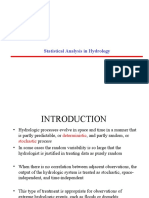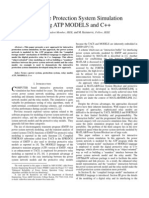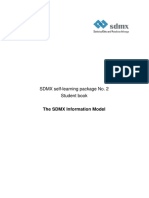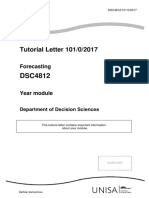0 ratings0% found this document useful (0 votes)
103 viewsStochastic Hydrology: Indian Institute of Science
This document provides an overview of stochastic hydrology as taught in a course. It introduces key concepts such as random variables, probability distributions, parameter estimation, time series analysis and applications in hydrology. Specific topics covered include one and multi-dimensional random variables, commonly used probability distributions, auto-regressive moving average models, and applications like flood forecasting, reservoir operations, and water quality modeling. Examples of random variables in hydrology and how to determine probability distributions from probability density functions are also demonstrated.
Uploaded by
kardraCopyright
© © All Rights Reserved
Available Formats
Download as PDF, TXT or read online on Scribd
0 ratings0% found this document useful (0 votes)
103 viewsStochastic Hydrology: Indian Institute of Science
This document provides an overview of stochastic hydrology as taught in a course. It introduces key concepts such as random variables, probability distributions, parameter estimation, time series analysis and applications in hydrology. Specific topics covered include one and multi-dimensional random variables, commonly used probability distributions, auto-regressive moving average models, and applications like flood forecasting, reservoir operations, and water quality modeling. Examples of random variables in hydrology and how to determine probability distributions from probability density functions are also demonstrated.
Uploaded by
kardraCopyright
© © All Rights Reserved
Available Formats
Download as PDF, TXT or read online on Scribd
You are on page 1/ 40
STOCHASTIC HYDROLOGY
Course Instructor : Prof. P. P. MUJUMDAR
Department of Civil Engg., IISc.
!"#!$" !"&'!'(') *+ &,!)",)
!"#$%& !"()&()%
Introduction to Random Variables (RVs)
Probability Distributions - One dimensional RVs
Higher Dimensional RVs Joint Distribution; Conditional
Distribution; Independence
Properties of Random Variables
Parameter Estimation Maximum Likelihood Method
and Method of Moments
Commonly Used Distributions in Hydrology
Hydrologic Data Generation
Introduction to Time Series Analysis
Purely stochastic Models; Markov Processes
!"#$%& !"()&()% *+"(),-
Analysis in the Frequency Domain : Spectral Density
Auto Correlation and Partial Auto Correlation
Auto Regressive Moving Average Models
(Box-Jenkins models model identification;
Parameter estimation ; calibration and validation ;
Simulation of hydrologic time series ; Applications to
Hydrologic Data Generation and Forecasting)
.&/&$&(+& 0""1%
Haan, C.T., "Statistical Methods in Hydrology", First
East-West Press Edition, New Delhi, 1995.
Bras, R.L. and Rodriguez-Iturbe , Random Functions
and Hydrology, Dover Publications, New York, USA,
1993.
Clarke, R.T., "Statistical Models in Hydrology", John
Wiley, Chinchester, 1994.
Yevjevich V. Probability and statistics in Hydrology,
Water Resources Publications, Colorado, 1972.
Ang, A.H.S. and Tang, W.H., "Probabilistic concepts in
Engineering Planning Design", Vol. 1, Wiley, New York,
1975.
Effluent
streamflow
Reservoir
Typical Water Resource System
Irrigated
Agriculture
! Hydro-power
R
iv
e
r
Non Point Source
Pollution
Groundwater Reservoir
Recharge
Rainfall
Rainfall
Base flow
Pumping
Catchment
Gauge-A
Reservoir
Regulated flow Streamflow
Time
(months)
Flow
(Mm
3
)
Mean flow
Observed (historical) flows at Gauge - A
Reservoir Design
and Operation
Medium term
forecasts for
hydropower/
irrigation/water
supply,
Short term
forecasts for flood
control
Stochastic Hydrology - Applications
History provides a valuable clue to the future
Rain Gauge
Stream Gauge
Rainfall
Stream Flow
Joint variation of rainfall
and streamflow in a
catchment
Rainfall-Runoff
relationships
Stochastic Hydrology - Applications
Real-time Flood Forecasting
'*-"
$
To forecast water levels at
A, with sufficient lead
time
Water level at A: Function of
rainfall in the catchment upstream,
evaporation, infiltration, storage,
vegetation and other catchment
characteristics.
Stochastic Hydrology - Applications
Multi-reservoir systems
Flood forecasting
Intermediate catchment flows
Long-term operation of the
system
Stochastic Hydrology
- Applications
Reliability of Meeting Future Demands
How often does the system Fail to
deliver?
Resiliency of the System
How quickly can the system recover
from failure?
Vulnerability of the system
Effect of a failure (e.g., expected flood
damages; deficit hydropower etc.)
Stochastic Hydrology - Applications
Rainfall AET
GW Pumping
Recharge
Canal Recharge
Release
D/S Flow
Inflow
RESERVOIR
IRRIGATED AREA
AQUIFER
C
o
n
j
u
n
c
t
i
v
e
u
s
e
o
f
s
u
r
f
a
c
e
a
n
d
g
r
o
u
n
d
w
a
t
e
r
Net
outflow
Stochastic Hydrology - Applications
Water Quality in Streams
Non-point Source Pollution
Governed by :
Streamflow,
Temperature,
Hydraulic properties,
Effluent discharges,
Non-point source
pollution, Reaction
rates !..
Stochastic Hydrology - Applications
Stochastic Hydrology - Applications
! Flood frequency analysis
! return period of critical events
! Probable Maximum Flood
! Intensity-Duration-Frequency relationships,
! Run-lengths : intervals between rainy days
! Time series, data generation, flow
forecasting
! Joint variation of flows in two or more streams
! Urban floods
Estimates of design rainfall intensity based on
probability concepts
! Spatial variation in aquifer parameters
! Uncertainties introduced by climate change
Likely changes in frequencies and magnitudes of
floods & droughts.
Likely changes in stream flow, precipitation patterns,
recharge to ground water
+
.
/
0
1
2
Stochastic Hydrology - Applications
Random Variable
Real-valued function defined on the sample space.
Element s in the
sample space
Y(s)
Y
Sample space of
an experiment
Possible real
values of Y
Y is a Random
Variable
Intuitively, a random variable (RV) is a
variable whose value cannot be known with
certainty, until the RV actually takes on a
value; In this sense, most hydrologic variables
are random variables
Random Variable
RVs of interest in hydrology
" Rainfall in a given duration
" Streamflow
" Soil hydraulic properties (e.g. permeability, porosity)
" Time between hydrologic events (e.g. floods of a
given magnitude)
" Evaporation/Evapotranspiration
" Ground water levels
" Re-aeration rates
Random Variable
Any function of a random variable is also a random
variable.
For example, if X is a r.v., then Z = g(X) is also r.v.
Capital letters will be used for denoting r.v.s and small
letters for the values they take
e.g. X rainfall, x = 30 mm
Y stream flow, y = 300 Cu.m.
We define events on the r.v. e.g. X=30 ; a <Y <b
We associate probabilities to occurrence of events
represented as P[X=30], P[a<Y<b] etc.
Discrete & Continuous R.V.s
Discrete R.V.: Set of values a random variable can
assume is finite (or countably infinite).
No. of rainy days in a month (0,1,2!.30)
Time (no of years) between two flood events (1,2!.)
Continuous R.V.: If the set of values a random variable can
assume is infinite (the r.v. can take on values on a
continuous scale)
Amount of rainfall occurring in a day
Streamflow during a period
Flood peak over threshold
Temperature
Probability Distributions
Discrete random variables: Probability Mass Function
p(x
i
) > 0 ; ! p(x
i
) = 1
i
x
1
x
2
x
3
x
n
x
n-1
. . . . . . . . . . .
.
p(x
i
)
p(x
i
) = P [X = x
i
]
Probability Distributions
Cumulative distribution function : discrete RV
F(x) =! p(x
i
)
x
i
< x
x
1
x
2
x
3
x
n
x
n-1
. . . . . . . . . . .
.
p(x
1
)
1.0
p(x
1
)+p(x
2
)
P[X = x
i
] = F(x
i
) F(x
i-1
)
The r.v., being discrete, cannot take values other
than x
1
, x
2
, x
3
!!!. x
n
; P[X = x] = 0 for x " x
1
,
x
2
, x
3
!!!. x
n
Some times, it is advantageous to treat
continuous r.v.s as discrete rvs.
e.g., we may discretise streamflow at a
location into a finite no. of class intervals and
associate probabilities of the streamflow
belonging to a given class
Continuous R.V.s
pdf # Probability Density Function f(x)
cdf # Cumulative Distribution Function F(x)
Any function satisfying
f(x) > 0 and
can be a pdf
( ) 1 f x
!
"!
=
#
a
x
b
f(x)
pdf is NOT probability, but a probability density & therefore
pdf value can be more than 1
Continuous RVs
P [x < X < x+dx]
x
dx
f(x)
[ ]
P
( ) lim ( ) 1
dx
x X x dx
f x f x dx
dx
!
"!
#!
< $ +
= =
%
where
Continuous RVs
PDF # Probability Density Function (Probability mass per
unit x)
P [x
1
<X<x
2
] =
2
1
( )
x
x
f x dx
!
x
x
2
f(x)
x
1
P[x
1
< X < x
2
] =
Continuous RVs
2
1
( )
x
x
f x dx
!
P[x
1
< X < x
2
] = F(x
2
) F(x
1
)
x
F(x)
x
1
x x
2
PDF CDF
P[a < X < b] is probability that x takes on a value
between a and b
equals area under the pdf between a and b
P[a < X < b] = F(b) F(a)
a
x
b
f(x)
P[a<X<b]
( ) ( ) ( )
b a b
a
f x dx f x dx f x dx
!" !"
= ! =
# # #
F (x) = P[X < x] = ( )
x
f x dx
!"
#
Continuous RVs
x
1
x
1
f(x)
F(x)
P[X < x
1
]
x x
PDF CDF
( )
( )
dF x
f x
dx
=
Cumulative Distribution Function
F (x) = P[X < x] = ( )
x
f x dx
!"
#
( )
a
f x dx
!"
#
3
f(x)
3
Area under pdf = 1
F(x)
1.0
P[X<a] =
= Area under the pdf up to
a
Max. value= 1
x
For continuous RVs, probability of the RV taking a value
exactly equal to a specified value is zero
That is P[X = x] = 0 ; X continuous
P[X = d] = P[d < X < d] =
P [x- "x < X < x+ "x] " 0
Because P[X = a] = 0 for continuous r.v.
P[a < X < b] = P[a < X < b] = P[a < X < b] = P[a < X < b]
( ) 0
d
d
f x dx =
!
P[X > a] =
( ) ( )
a
f x dx f x dx
!
"! "!
= "
# #
x
a
f(x)
1-P[X<a]
Area indicates P[X>a]
( )
a
f x dx
!
"
= 1 F(a)
= 1 P[X < a]
P[x > a] = 1 P[x < a]
Mixed Distributions
P [X = d] " 0
A finite probability associated with a discrete event X = d
At other values that X can assume, there may be a
continuous distribution.
e.g., probability distribution of rainfall during a day:
there is a finite probability associated with a day being
a non-rainy day, i.e., P [X=0], where x is rainfall during
a day; and for x"0, the r.v. has a continuous
distribution ;
[ ]
1 2
( ) ( ) 1.0
d
d
f x dx P x d f x dx
!
"!
+ = + =
# #
x
f
1
(x)
P[X=d]
X=d
f
2
(x)
Mixed Distributions
In this case, P [X < d] " P [X < d]
1.0
x
"F=P[X=d]
d
F(x)
F(0) = P [X < 0] = P(X=0), in this case.
x
x
0
P[X=0]
f(x), x>0
1.0
F(x)
0
f(x)
Distribution of
rainfall during a day
Example Problem
f(x) = a.x
2
0 < x < 4
= 0 otherwise
1. Determine the constant a
( ) 1 f x dx
!
"!
=
#
2
4
3
0
. 1
1
3
a x dx
x
a
!
"!
=
# $
=
% &
' (
)
Gives a = 3/64 and f(x) = 3x
2
/64; 0 < x < 4
2. Determine F(x)
0
( ) ( ) ( )
x x
F x f x dx f x dx
!"
= =
# #
2
0
3
0
3
64
3
64 3
x
x
x
dx
x
=
! "
=
# $
% &
'
3
( ) 0 4
64
x
F x x = ! !
( )
3
3 27
P[X 3] F 3
64 64
! = = =
Then, for
example,
P[X < 4] = F(4) = 1.0
P[1 < X < 3] = F(3) - F(1) = 26/64
P [X>6] From the definition of the pdf, this must be zero
P [X>6] = 1 - P[X < 6]
= 1 [ 0 + 1.0 + 0 ]
= 0
0 4 6
0 4
1 ( ) ( ) ( ) f x dx f x dx f x dx
!"
# $
= ! + +
% &
' (
) ) )
Example problem
Consider the following pdf
f(x) = x>0
1. Derive the cdf
2. What is the probability that x lies between 3 and 5
3. Determine x such that P[X < x] = 0.5
4. Determine x such that P[X > x] = 0.75
/5
1
5
x
e
!
1. CDF:
2. P[3< X < 5] = F(5) - F(3)
= 0.63 0.45
= 0.18
0
( ) ( ) ( )
x x
F x f x dx f x dx
!"
= =
# #
/5
0
/5
0
1
5
x
x
x
x
e dx
e
!
!
=
" #
= !
$ %
&
/5
( ) 1
x
F x e
!
" #
= !
$ %
3. Determine x such that P[X < x] = 0.5
4. Determine x such that P[X > x] = 0.75
/5
1 0.5
/ 5 ln0.5
3.5
x
e
x
x
!
" #
! =
$ %
! =
=
[ ]
/5
/5
P[X x] 1 0.75
1 1 0.75
0.75
/ 5 ln 0.75
1.44
x
x
P X x
e
e
x
x
!
!
" = ! # =
$ %
! ! =
& '
=
! =
=
You might also like
- Time Series For Data Science Analysis and Forecasting (Wayne A. Woodward, Bivin Philip Sadler Etc.) (Z-Library)100% (1)Time Series For Data Science Analysis and Forecasting (Wayne A. Woodward, Bivin Philip Sadler Etc.) (Z-Library)529 pages
- Global Equity Fundamental Factor Model PDF100% (1)Global Equity Fundamental Factor Model PDF36 pages
- 2014 Data Analytics For Renewable Energy Integration PDFNo ratings yet2014 Data Analytics For Renewable Energy Integration PDF159 pages
- Hydrologic Statistics: Reading: Chapter 11 in Applied Hydrology Some Slides by Venkatesh MerwadeNo ratings yetHydrologic Statistics: Reading: Chapter 11 in Applied Hydrology Some Slides by Venkatesh Merwade28 pages
- Lab 3 Mapping Stock and Flow and Metal SimulationNo ratings yetLab 3 Mapping Stock and Flow and Metal Simulation10 pages
- Observing Interaction - An Introduction To Sequential Analysis100% (1)Observing Interaction - An Introduction To Sequential Analysis221 pages
- Fractional Calculus: Basic Theory and Applications: (Part III)No ratings yetFractional Calculus: Basic Theory and Applications: (Part III)18 pages
- Hydrologic Statistics: Reading: Chapter 11 in Applied Hydrology Some Slides by Venkatesh MerwadeNo ratings yetHydrologic Statistics: Reading: Chapter 11 in Applied Hydrology Some Slides by Venkatesh Merwade28 pages
- Flood Frequency Analysis: Reading: Applied Hydrology Sec 12.1 - 12.6No ratings yetFlood Frequency Analysis: Reading: Applied Hydrology Sec 12.1 - 12.635 pages
- Quantification of Permeability Heterogeneity For Reservoir Uncertainty QuantificationNo ratings yetQuantification of Permeability Heterogeneity For Reservoir Uncertainty Quantification17 pages
- Darcy'S Law: Groundwater Hydraulics Daene C. MckinneyNo ratings yetDarcy'S Law: Groundwater Hydraulics Daene C. Mckinney42 pages
- Introduction To Groundwater Modelling: DR Munendra Kumar DTUNo ratings yetIntroduction To Groundwater Modelling: DR Munendra Kumar DTU119 pages
- Introduction To Groundwater Modelling: C. P. KumarNo ratings yetIntroduction To Groundwater Modelling: C. P. Kumar119 pages
- Statistics and Probability in Flow AnalysisNo ratings yetStatistics and Probability in Flow Analysis39 pages
- CE3013 Lecture Note 5-1 Hydrological AnalysisNo ratings yetCE3013 Lecture Note 5-1 Hydrological Analysis60 pages
- Population at Risk: Risk Analysis For Information and Systems EngineeringNo ratings yetPopulation at Risk: Risk Analysis For Information and Systems Engineering9 pages
- Conservation Laws of Fluid Motion: 2.1 Governing Equations of Fluid Flow and Heat TransferNo ratings yetConservation Laws of Fluid Motion: 2.1 Governing Equations of Fluid Flow and Heat Transfer16 pages
- P361 Lecture2 Vector Differential Integral OperatorsNo ratings yetP361 Lecture2 Vector Differential Integral Operators28 pages
- Concept of Probability and Statistics Hydrology: By:Ellah Niña B. Mantos Bsce-4ANo ratings yetConcept of Probability and Statistics Hydrology: By:Ellah Niña B. Mantos Bsce-4A33 pages
- Mathematics of Seismic Imaging: William W. SymesNo ratings yetMathematics of Seismic Imaging: William W. Symes54 pages
- On Probability Theory &stochastic ProcessNo ratings yetOn Probability Theory &stochastic Process101 pages
- Numerical Methods For Pdes: Spring 2007No ratings yetNumerical Methods For Pdes: Spring 200735 pages
- Lecture10 PTEG-431 SinglePhase 19.09.2018No ratings yetLecture10 PTEG-431 SinglePhase 19.09.201848 pages
- Hydrology 510 Quantitative Methods in Hydrology: MotiveNo ratings yetHydrology 510 Quantitative Methods in Hydrology: Motive57 pages
- Lecture Packet #4: Continuity and Flow Nets: Dydz QNo ratings yetLecture Packet #4: Continuity and Flow Nets: Dydz Q13 pages
- Calculus of Variations: Mechanics, Control and Other ApplicationsFrom EverandCalculus of Variations: Mechanics, Control and Other ApplicationsNo ratings yet
- Introduction to the Mathematics of Inversion in Remote Sensing and Indirect MeasurementsFrom EverandIntroduction to the Mathematics of Inversion in Remote Sensing and Indirect MeasurementsNo ratings yet
- Interactive Protection Using ATP Models PDFNo ratings yetInteractive Protection Using ATP Models PDF6 pages
- Shunt Compensation On Ehv Transmission LineNo ratings yetShunt Compensation On Ehv Transmission Line9 pages
- Component Modeling: Power System StructureNo ratings yetComponent Modeling: Power System Structure3 pages
- Subscripting in Vensim 2 - Introducing, Progressing Between, Mapping and Creating Subranges of SubscriptsNo ratings yetSubscripting in Vensim 2 - Introducing, Progressing Between, Mapping and Creating Subranges of Subscripts41 pages
- Regional Ow-Duration Curves: Reliability For Ungauged BasinsNo ratings yetRegional Ow-Duration Curves: Reliability For Ungauged Basins13 pages
- Supplemental Lecture - Sensitivity AnalysesNo ratings yetSupplemental Lecture - Sensitivity Analyses23 pages
- Course-Structure-Syllabi-BCom 1-101-140No ratings yetCourse-Structure-Syllabi-BCom 1-101-14040 pages
- 02 SDMX Information Model Student Book 2010 PDFNo ratings yet02 SDMX Information Model Student Book 2010 PDF30 pages
- (FREE PDF Sample) Business Analytics James R. Evans Ebooks100% (4)(FREE PDF Sample) Business Analytics James R. Evans Ebooks62 pages
- Buy ebook Deep Learning Toolbox Getting Started Guide MATLAB The Mathworks cheap price100% (1)Buy ebook Deep Learning Toolbox Getting Started Guide MATLAB The Mathworks cheap price40 pages
- WQU - Econometrics - Module - 7 - Compiled Content PDFNo ratings yetWQU - Econometrics - Module - 7 - Compiled Content PDF59 pages
- Quasi-Dynamic Simulation June 21 2021: Who Should AttendNo ratings yetQuasi-Dynamic Simulation June 21 2021: Who Should Attend1 page
- When Will European Muslim Population Be Majority and in Which Country?No ratings yetWhen Will European Muslim Population Be Majority and in Which Country?22 pages
- Student Developed Shiny Applications For Teaching StatisticsNo ratings yetStudent Developed Shiny Applications For Teaching Statistics11 pages
- Mastering R For Quantitative Finance - Sample Chapter67% (3)Mastering R For Quantitative Finance - Sample Chapter40 pages
- Shaaron Ainsworth, 2008. The Education Value of Multiple-RepresentationsNo ratings yetShaaron Ainsworth, 2008. The Education Value of Multiple-Representations18 pages
- Data Mining and Predictive Modelling: (CSET228)No ratings yetData Mining and Predictive Modelling: (CSET228)14 pages
- A Machine Learning Approach For Forecasting Hierarchical Time SeriesNo ratings yetA Machine Learning Approach For Forecasting Hierarchical Time Series17 pages
- Penggunaan Model Arima Dalam Peramalan Suhu Udara Di Sekitar PalangkarayaNo ratings yetPenggunaan Model Arima Dalam Peramalan Suhu Udara Di Sekitar Palangkaraya37 pages
- Business Statistics Important Theory QuestionsNo ratings yetBusiness Statistics Important Theory Questions22 pages
- Time Series For Data Science Analysis and Forecasting (Wayne A. Woodward, Bivin Philip Sadler Etc.) (Z-Library)Time Series For Data Science Analysis and Forecasting (Wayne A. Woodward, Bivin Philip Sadler Etc.) (Z-Library)
- 2014 Data Analytics For Renewable Energy Integration PDF2014 Data Analytics For Renewable Energy Integration PDF
- Hydrologic Statistics: Reading: Chapter 11 in Applied Hydrology Some Slides by Venkatesh MerwadeHydrologic Statistics: Reading: Chapter 11 in Applied Hydrology Some Slides by Venkatesh Merwade
- Observing Interaction - An Introduction To Sequential AnalysisObserving Interaction - An Introduction To Sequential Analysis
- Fractional Calculus: Basic Theory and Applications: (Part III)Fractional Calculus: Basic Theory and Applications: (Part III)
- Hydrologic Statistics: Reading: Chapter 11 in Applied Hydrology Some Slides by Venkatesh MerwadeHydrologic Statistics: Reading: Chapter 11 in Applied Hydrology Some Slides by Venkatesh Merwade
- Flood Frequency Analysis: Reading: Applied Hydrology Sec 12.1 - 12.6Flood Frequency Analysis: Reading: Applied Hydrology Sec 12.1 - 12.6
- Quantification of Permeability Heterogeneity For Reservoir Uncertainty QuantificationQuantification of Permeability Heterogeneity For Reservoir Uncertainty Quantification
- Darcy'S Law: Groundwater Hydraulics Daene C. MckinneyDarcy'S Law: Groundwater Hydraulics Daene C. Mckinney
- Introduction To Groundwater Modelling: DR Munendra Kumar DTUIntroduction To Groundwater Modelling: DR Munendra Kumar DTU
- Introduction To Groundwater Modelling: C. P. KumarIntroduction To Groundwater Modelling: C. P. Kumar
- Population at Risk: Risk Analysis For Information and Systems EngineeringPopulation at Risk: Risk Analysis For Information and Systems Engineering
- Conservation Laws of Fluid Motion: 2.1 Governing Equations of Fluid Flow and Heat TransferConservation Laws of Fluid Motion: 2.1 Governing Equations of Fluid Flow and Heat Transfer
- P361 Lecture2 Vector Differential Integral OperatorsP361 Lecture2 Vector Differential Integral Operators
- Concept of Probability and Statistics Hydrology: By:Ellah Niña B. Mantos Bsce-4AConcept of Probability and Statistics Hydrology: By:Ellah Niña B. Mantos Bsce-4A
- Hydrology 510 Quantitative Methods in Hydrology: MotiveHydrology 510 Quantitative Methods in Hydrology: Motive
- Lecture Packet #4: Continuity and Flow Nets: Dydz QLecture Packet #4: Continuity and Flow Nets: Dydz Q
- Shortcuts to College Calculus Refreshment KitFrom EverandShortcuts to College Calculus Refreshment Kit
- Calculus of Variations: Mechanics, Control and Other ApplicationsFrom EverandCalculus of Variations: Mechanics, Control and Other Applications
- Introduction to the Mathematics of Inversion in Remote Sensing and Indirect MeasurementsFrom EverandIntroduction to the Mathematics of Inversion in Remote Sensing and Indirect Measurements
- Subscripting in Vensim 2 - Introducing, Progressing Between, Mapping and Creating Subranges of SubscriptsSubscripting in Vensim 2 - Introducing, Progressing Between, Mapping and Creating Subranges of Subscripts
- Regional Ow-Duration Curves: Reliability For Ungauged BasinsRegional Ow-Duration Curves: Reliability For Ungauged Basins
- (FREE PDF Sample) Business Analytics James R. Evans Ebooks(FREE PDF Sample) Business Analytics James R. Evans Ebooks
- Buy ebook Deep Learning Toolbox Getting Started Guide MATLAB The Mathworks cheap priceBuy ebook Deep Learning Toolbox Getting Started Guide MATLAB The Mathworks cheap price
- WQU - Econometrics - Module - 7 - Compiled Content PDFWQU - Econometrics - Module - 7 - Compiled Content PDF
- Quasi-Dynamic Simulation June 21 2021: Who Should AttendQuasi-Dynamic Simulation June 21 2021: Who Should Attend
- When Will European Muslim Population Be Majority and in Which Country?When Will European Muslim Population Be Majority and in Which Country?
- Student Developed Shiny Applications For Teaching StatisticsStudent Developed Shiny Applications For Teaching Statistics
- Mastering R For Quantitative Finance - Sample ChapterMastering R For Quantitative Finance - Sample Chapter
- Shaaron Ainsworth, 2008. The Education Value of Multiple-RepresentationsShaaron Ainsworth, 2008. The Education Value of Multiple-Representations
- A Machine Learning Approach For Forecasting Hierarchical Time SeriesA Machine Learning Approach For Forecasting Hierarchical Time Series
- Penggunaan Model Arima Dalam Peramalan Suhu Udara Di Sekitar PalangkarayaPenggunaan Model Arima Dalam Peramalan Suhu Udara Di Sekitar Palangkaraya









































































































